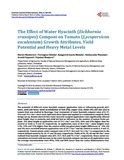Please use this identifier to cite or link to this item:
https://cris.library.msu.ac.zw//handle/11408/3813| Title: | The effect of water hyacinth (Eichhornia crassipes) compost on tomato (Lycopericon esculentum) growth attributes, yield potential and heavy metal levels | Authors: | Mashavira, Martin Chitata, Tavengwa Mhindu, Rangarirai Lucia Muzemu, Simbarashe Kapenzi, Arnold Manjeru, Pepukai |
Keywords: | Heavy metal concentration Lycopersicon esculentum Tomato production |
Issue Date: | 2015 | Series/Report no.: | American Journal of Plant Sciences;Vol. 6: p. 545-553 | Abstract: | The potential of different water hyacinth compost application rates in influencing growth attributes, yield and heavy metal accumulation of lead (Pb), copper (Cu), nickel (Ni) and zinc (Zn) in tomato fruit was studied in Masvingo. Four treatments of water hyacinth compost rates of 0, 37, 55.6 and 74.1 t·ha-1 were each replicated three times and applied in a randomized complete block design set up. Results showed that water hyacinth compost application rates significantly affected plant height, days to maturity and yield but had no influence on the number of tomato fruits per plant. The plant height at application rate of 74.1 t·ha-1 was 25%, 56% and 63% higher than the control at week 6, 9 and 12, respectively. At application rates of 56.6 t·ha-1, plant heights were 11%, 13% and 12% higher than the control whilst marginal plant height differences of -4%, 6% and 4% were recorded between application rate of 34.7 t·ha-1 and the control at week 6, 9 and 12, respectively. Tomato plants under compost rates of 34.7, 56.6 and 74.1 t·ha-1 in comparison to the control delayed maturity by 10, 17 and 20 days, respectively. Yields of 52, 55, 60 and 68 t·ha-1 were realized from hyacinth compost rates of 0, 34.7, 56.6 and 74.1 t·ha-1, respectively. Heavy metal concentrations increased with increase in the water hyacinth compost rate but at all application rates, the average concentrations were 85%, 93% and 86% lower than the Codex Alimentarious Commission permissible levels for Pb, Cu and Zn. Water hyacinth compost at a rate of 74 t·ha-1 therefore can be used for increased tomato yield without exposing consumers to heavy metal toxicity. | URI: | https://m.scirp.org/papers/54496 http://hdl.handle.net/11408/3813 |
ISSN: | 2158-2742 |
| Appears in Collections: | Research Papers |
Files in This Item:
| File | Description | Size | Format | |
|---|---|---|---|---|
| Tomato Production.pdf | Full Text | 5.3 MB | Adobe PDF |  View/Open |
Page view(s)
200
checked on Dec 19, 2025
Download(s)
114
checked on Dec 19, 2025
Google ScholarTM
Check
Items in MSUIR are protected by copyright, with all rights reserved, unless otherwise indicated.



